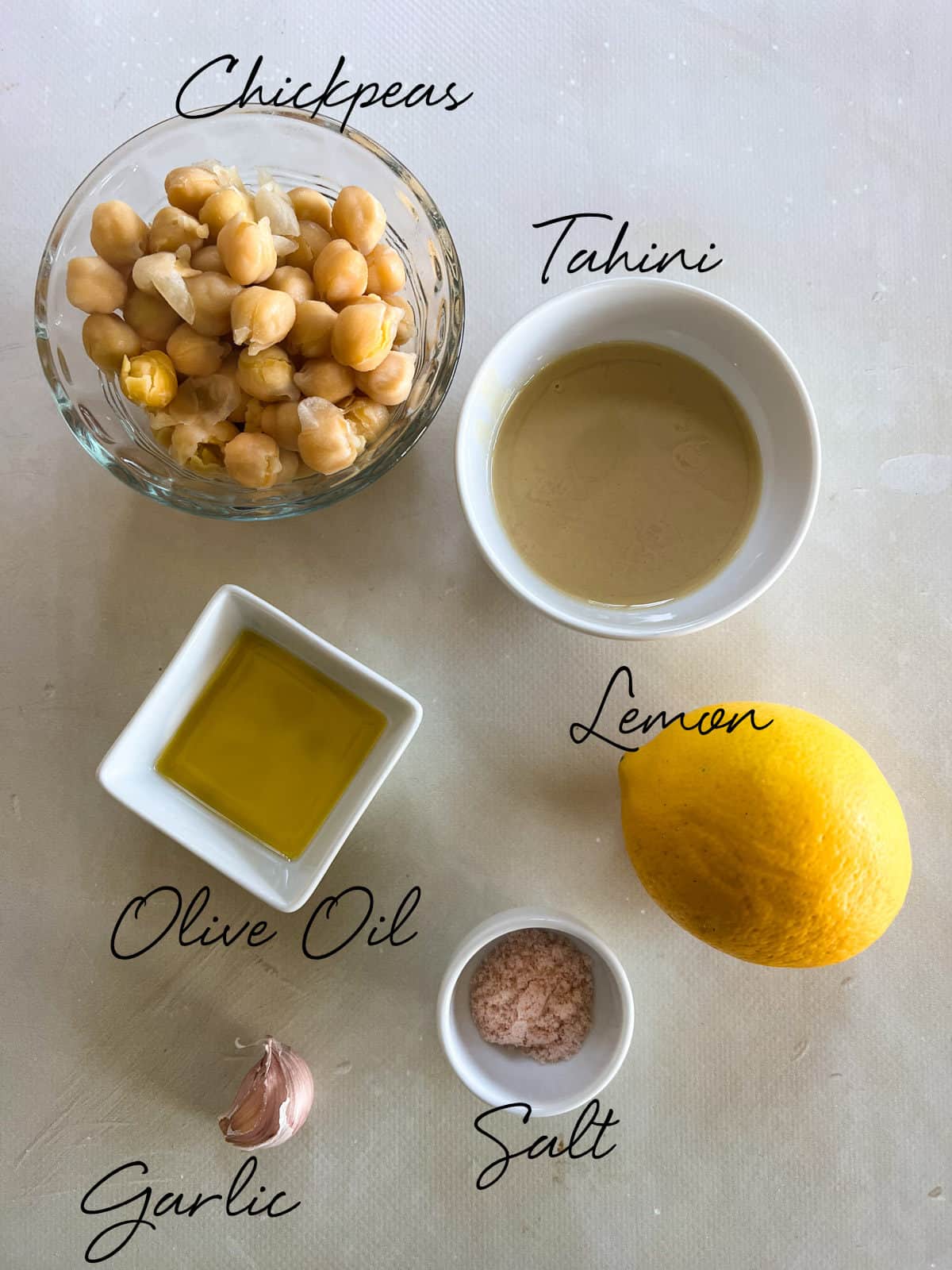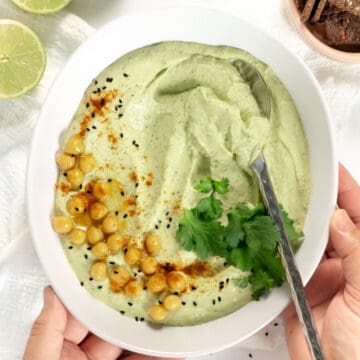Lebanese Musabaha is creamy chickpeas mixed with tahini, lemon, garlic topped with olive oil. It is usually enjoyed at breakfast time, accompanied by fresh and pickled vegetables and pita bread.

This website receives a commission/fee for each purchase bought through the affiliate links on this website.
Jump to:
What is Musabaha?
Musabaha is an ancient Middle Eastern dish made of creamed tender warm chickpeas (garbanzo beans) that have been left semi chunky mixed through a sauce.
Generally served during breakfast, this popular Levant dish can be altered to suit your taste and can be referred to as hummus musabaha, it is a variant of balila.
Different ingredients are used in various Middle Eastern countries.
Musabaha in English
The word musabaha or msabha or msabaha translates from Arabic to English as “swimming” it is pronounced as mmsab·ha. Pronunciation will differ between regions.
Musabaha is the name of the dish as it references the chickpeas swimming in a pool of juices.
😋Why You’ll Love This Recipe
- A simple and inexpensive meal
- An easy to prepare chickpeas breakfast using simple ingredients (but hey, eat it anytime)
- Dietary friendly - naturally gluten-free and vegan, soy and corn-free.
✔️Ingredients You’ll Need

Chickpeas - dry or canned can be used. If using canned, go for the organic variety.
I prefer to use dry chickpeas as they are way creamier and the flavor is better in every way possible.
Fresh lemon juice adds a nice mild sourness to musabaha.
Tahini bolsters the creaminess of the chickpeas and gives a nutty taste
Olive oil - use a high-quality extra virgin olive oil. Generally, a copious amount of it is used to dress the chickpeas. I have however limited to one tablespoon in this recipe - personal preference.
Crushed garlic clove, again use fresh and you can adjust the amount used to suit your taste.
🔪How to Make Musabaha
Dry Chickpeas
Step 1 - Sort chickpea pieces (discard any bad beans) and then soak overnight in water (1 cup of chickpeas to 5 cups of water). The next morning, pour chickpeas and their water into a pot, bring to a soft boil over high heat and then turn down to low heat and cook with the lid partially open for approximately 50 minutes. This will ensure they are really tender and almost falling apart. Skim off any froth.
Canned Chickpeas
Step 1 - Add chickpeas with their brine to a pot and cook them until they are starting to fall apart.
Step 2 - In a bowl, add salt, garlic, and lemon juice. Mix until well combined and the salt has dissolved. Add chickpeas and mash them until they are chunky. Add brine, and tahini and mash further until they are semi-chunky. The consistency should be a mixture of smooth and chunky. Top with olive oil and a few whole chickpeas and serve warm with suggested garnishes.

🥗Serving Suggestion
Top with a flavorsome shatta (Middle Eastern hot sauce) and then rip off a piece of Lebanese bread (pita bread) to scoop the musabaha and enjoy a fresh plate of fresh and pickled vegetables (fresh mint, tomato, radish, pickled turnip known as lifit (affiliate link), olives, pickled green chili, and pickled Armenian cucumbers (snake cucumbers) (affiliate link).
As a snack, try it with some crackers using my gluten free crackers recipe.
🌿Garnish Suggestions
Some of the traditional garnishes found include;
Chopped parsley and mint leaves
Whole tender chickpeas - I love the contrast in textures when I add these on top
Paprika, sumac, cumin, chili powder
Diced fresh tomato
🌟Pro Tips
The ingredients can be altered to suit your taste.
Use only good quality ingredients, this makes the world of difference to the flavors.
Musabaha is generally topped with a generous amount of olive oil, I personally have limited it down to a spoonful. You can adjust this to your liking.
🥄Variations
Some people like to add a spoonful of yogurt. This can be referred to as laban ma hummus, which means yogurt with chickpeas.
Garlic can be left out.
Freshly chopped parsley can be mixed through this chickpeas breakfast.

❓FAQ
The difference between musabaha and hummus is the texture and the taste. Msabha is a chunky texture that is slightly sweeter due to the chickpeas not being completely blended. Hummus is a smooth pureed texture. The ingredients are very similar, the difference is down to the geographical location (varying between Middle Eastern countries) and personal preference.
Although musabaha is best eaten fresh, left-overs can be stored. Once it has cooled down, place it in an air-tight sealed container in the fridge for up to five days. It should be reheated before consumption.
🥘Related Recipes
Other Lebanese recipes you might enjoy include balela salad, a spinoff of balila. Or creamy Lebanese hummus.
Or my easy zaatar pastries and for something sweet my Lebanese milk pudding.
Recipe

Easy Creamy Lebanese Musabaha (Chickpeas Breakfast)
Ingredients
- 1 cup Chickpeas cooked
- 1 clove Garlic crushed
- ⅛ cup Tahini
- ½ small Lemon freshly squeezed
- ½ teaspoon Salt or to taste
- ⅛-¼ cup Chickpea brine aquafaba
- 1 tablespoon Olive oil or to taste
Instructions
- If using dry chickpeas - sort chickpea pieces (discard any bad beans) and then soak overnight in water (1 cup of chickpeas to 5 cups of water). The next morning, pour chickpeas and their water into a pot, bring to a soft boil over high heat and then turn down to low heat and cook with lid partially open for approximately 50 minutes. This will ensure they are really tender and almost falling apart. Skim off any froth.If using canned chickpeas - add chickpeas with their brine to a pot and cook them until they are starting to fall apart.1 cup Chickpeas
- In a bowl, add salt, garlic and lemon juice. Mix until well combined and the salt has dissolved. Add chickpeas and mash them until they are chunky. Add brine, tahini and mash further until they are semi chunky. The consistency should be a mixture of smooth and chunky. Top with olive oil and a few whole chickpeas and serve warm with suggested garnishes.1 clove Garlic, ⅛ cup Tahini, ½ small Lemon, ½ teaspoon Salt, ⅛-¼ cup Chickpea brine, 1 tablespoon Olive oil
Video
Notes
Nutrition
N.B., nutrition info is an estimate based on an online nutrition calculator. This will vary based on the specific ingredients you use.
If you enjoyed this recipe, consider supporting my work for the cost of a cup of coffee.










Jen
Chickpeas are a good source of protein, never thought I could enjoy them for breakfast too. Thanks for the delicious recipe
Addie
This was so hearty and flavorful! I love the garlic and tahini flavors in there. I learn so many new recipes from you, thank you
Susan
Thank you for this! I was wondering about the difference with hummus. I used a can of garbanzo beans yesterday and it was delicious.
Andre
I'm just now trying out more Lebanese dishes and this dish is another new favorite! So savory and delicious!
Gloria
I have not heard of this. I LOVE hummus, so this was a nice change. I just bought a case of chickpeas today....gave this a try.